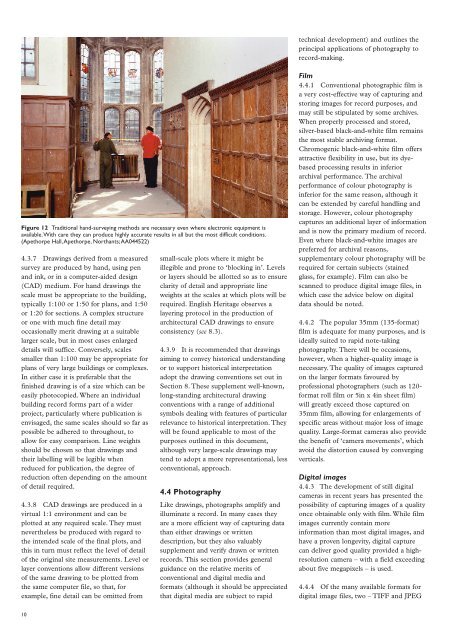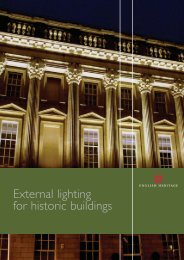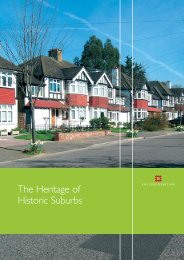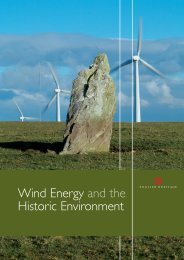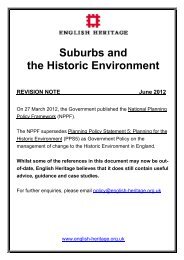Understanding Historic Buildings - HELM
Understanding Historic Buildings - HELM
Understanding Historic Buildings - HELM
You also want an ePaper? Increase the reach of your titles
YUMPU automatically turns print PDFs into web optimized ePapers that Google loves.
Figure 12 Traditional hand-surveying methods are necessary even where electronic equipment is<br />
available.With care they can produce highly accurate results in all but the most difficult conditions.<br />
(Apethorpe Hall, Apethorpe, Northants; AA044522)<br />
4.3.7 Drawings derived from a measured<br />
survey are produced by hand, using pen<br />
and ink, or in a computer-aided design<br />
(CAD) medium. For hand drawings the<br />
scale must be appropriate to the building,<br />
typically 1:100 or 1:50 for plans, and 1:50<br />
or 1:20 for sections. A complex structure<br />
or one with much fine detail may<br />
occasionally merit drawing at a suitable<br />
larger scale, but in most cases enlarged<br />
details will suffice. Conversely, scales<br />
smaller than 1:100 may be appropriate for<br />
plans of very large buildings or complexes.<br />
In either case it is preferable that the<br />
finished drawing is of a size which can be<br />
easily photocopied. Where an individual<br />
building record forms part of a wider<br />
project, particularly where publication is<br />
envisaged, the same scales should so far as<br />
possible be adhered to throughout, to<br />
allow for easy comparison. Line weights<br />
should be chosen so that drawings and<br />
their labelling will be legible when<br />
reduced for publication, the degree of<br />
reduction often depending on the amount<br />
of detail required.<br />
4.3.8 CAD drawings are produced in a<br />
virtual 1:1 environment and can be<br />
plotted at any required scale. They must<br />
nevertheless be produced with regard to<br />
the intended scale of the final plots, and<br />
this in turn must reflect the level of detail<br />
of the original site measurements. Level or<br />
layer conventions allow different versions<br />
of the same drawing to be plotted from<br />
the same computer file, so that, for<br />
example, fine detail can be omitted from<br />
10<br />
small-scale plots where it might be<br />
illegible and prone to ‘blocking in’. Levels<br />
or layers should be allotted so as to ensure<br />
clarity of detail and appropriate line<br />
weights at the scales at which plots will be<br />
required. English Heritage observes a<br />
layering protocol in the production of<br />
architectural CAD drawings to ensure<br />
consistency (see 8.3).<br />
4.3.9 It is recommended that drawings<br />
aiming to convey historical understanding<br />
or to support historical interpretation<br />
adopt the drawing conventions set out in<br />
Section 8. These supplement well-known,<br />
long-standing architectural drawing<br />
conventions with a range of additional<br />
symbols dealing with features of particular<br />
relevance to historical interpretation. They<br />
will be found applicable to most of the<br />
purposes outlined in this document,<br />
although very large-scale drawings may<br />
tend to adopt a more representational, less<br />
conventional, approach.<br />
4.4 Photography<br />
Like drawings, photographs amplify and<br />
illuminate a record. In many cases they<br />
are a more efficient way of capturing data<br />
than either drawings or written<br />
description, but they also valuably<br />
supplement and verify drawn or written<br />
records. This section provides general<br />
guidance on the relative merits of<br />
conventional and digital media and<br />
formats (although it should be appreciated<br />
that digital media are subject to rapid<br />
technical development) and outlines the<br />
principal applications of photography to<br />
record-making.<br />
Film<br />
4.4.1 Conventional photographic film is<br />
a very cost-effective way of capturing and<br />
storing images for record purposes, and<br />
may still be stipulated by some archives.<br />
When properly processed and stored,<br />
silver-based black-and-white film remains<br />
the most stable archiving format.<br />
Chromogenic black-and-white film offers<br />
attractive flexibility in use, but its dyebased<br />
processing results in inferior<br />
archival performance. The archival<br />
performance of colour photography is<br />
inferior for the same reason, although it<br />
can be extended by careful handling and<br />
storage. However, colour photography<br />
captures an additional layer of information<br />
and is now the primary medium of record.<br />
Even where black-and-white images are<br />
preferred for archival reasons,<br />
supplementary colour photography will be<br />
required for certain subjects (stained<br />
glass, for example). Film can also be<br />
scanned to produce digital image files, in<br />
which case the advice below on digital<br />
data should be noted.<br />
4.4.2 The popular 35mm (135-format)<br />
film is adequate for many purposes, and is<br />
ideally suited to rapid note-taking<br />
photography. There will be occasions,<br />
however, when a higher-quality image is<br />
necessary. The quality of images captured<br />
on the larger formats favoured by<br />
professional photographers (such as 120format<br />
roll film or 5in x 4in sheet film)<br />
will greatly exceed those captured on<br />
35mm film, allowing for enlargements of<br />
specific areas without major loss of image<br />
quality. Large-format cameras also provide<br />
the benefit of ‘camera movements’, which<br />
avoid the distortion caused by converging<br />
verticals.<br />
Digital images<br />
4.4.3 The development of still digital<br />
cameras in recent years has presented the<br />
possibility of capturing images of a quality<br />
once obtainable only with film. While film<br />
images currently contain more<br />
information than most digital images, and<br />
have a proven longevity, digital capture<br />
can deliver good quality provided a highresolution<br />
camera – with a field exceeding<br />
about five megapixels – is used.<br />
4.4.4 Of the many available formats for<br />
digital image files, two – TIFF and JPEG


